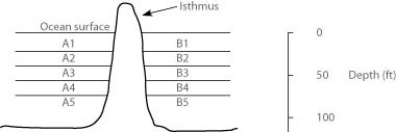Multiple Choice
Use the following description to answer the question.
In the oceans on either side of the Isthmus of Panama are 30 species of snapping shrimp; some are shallow-water species, others are adapted to deep water. There are 15 species on the Pacific side and 15 different species on the Atlantic side. The Isthmus of Panama started rising about 10 million years ago. The oceans were completely separated by the isthmus about 3 million years ago.
In the figure, the isthmus separates the Pacific Ocean on the left (side A) from the Atlantic Ocean on the right (side B) . The seawater on either side of the isthmus is separated into five depth habitats (1-5) , with 1 being the shallowest.
Why should deepwater shrimp on different sides of the isthmus have diverged from each other earlier than shallow-water shrimp?
A) They have been geographically isolated from each other for a longer time.
B) Cold temperatures, associated with deep water, have accelerated the mutation rate, resulting in faster divergence in deepwater shrimp.
C) The rise of the land bridge was accompanied by much volcanic activity. Volcanic ash contains heavy metals, which are known mutagens. Ash fall caused high levels of heavy metals in the ocean sediments underlying the deep water, resulting in accelerated mutation rates and faster divergence in deepwater shrimp.
D) Fresh water entering the ocean from the canal is both less dense and cloudier than seawater. The cloudy fresh water interferes with the ability of shallow-water shrimp to locate mating partners, which reduces the frequency of mating, thereby slowing the introduction of genetic variation.
Correct Answer:

Verified
Correct Answer:
Verified
Q23: Which of the following factors would not
Q29: Which of the various species concepts distinguishes
Q32: The largest unit within which gene flow
Q51: The production of sterile mules by interbreeding
Q53: The question refers to the following evolutionary
Q54: There is still some controversy among biologists
Q57: Use the following information to answer the
Q59: Use the following description to answer the
Q60: In a hypothetical situation, a certain species
Q61: You are confronted with a box of